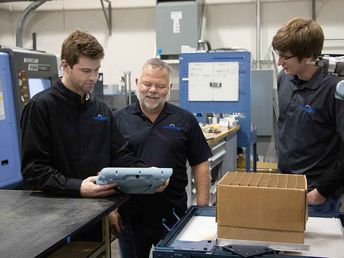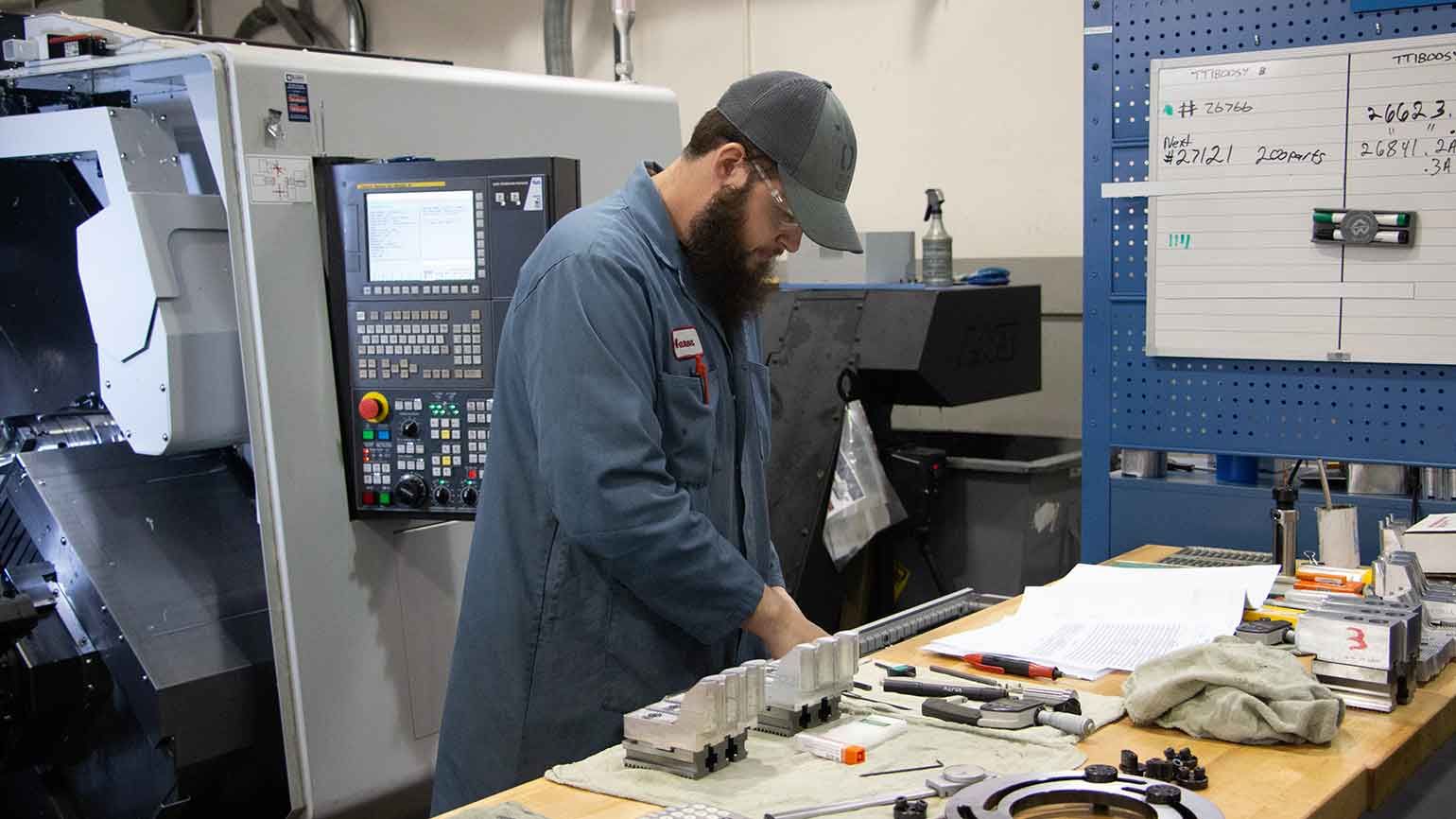In the injection molding department, a UR5 robot is used for an intricate plastic extrusion assembly, picking up end caps for a plastic panel, moving them through a glue dispenser. After correct dispensing of the glue in the end cap, the UR5 places the part in an actuator on a table where the part is clamped. An operator then takes over, inspects the gluing, and removes the part. This task used to require four operators to produce about two hundred units per day.


Universal Robots doubles production at metal and plastic manufacturer
In short
Tacoma, Washington-based Tool Gauge manufactures precision metal and plastic components and assemblies for the aerospace industry. With long-term customer contracts that can’t be renegotiated, Tool Gauge turned to automation to help mitigate and contain staffing costs in a tight labor market. Two UR collaborative robots accomplished that goal, delivering labor savings up to 75 percent while doubling production in glue dispensing and CNC machine tending applications, reducing the need for additional workers for repetitive, undesirable jobs. The company also found new opportunities for employees to add value, improve safety, and gain job satisfaction.
The business transformation
Jim Lee, Tool Gauge general manager, faces the stark realities of doing business in a global market. Even though the company is close to many of its customers in the Pacific Northwest, those customers can do business anywhere in the world, including in much lower-cost labor markets. “It became clear to us that the way that we can compete is not by adding more bodies but by adding more technology, and then adding more value using that technology,” explains Lee who was looking to hire as many as a hundred new employees that simply weren’t available in the tight Pacific Northwest labor market.
Not only was it difficult for a Tool Gauge to hire human operators, the required tasks were also difficult for manual labor to perform – especially dispensing glue into plastic extruded parts. “The area the glue needs to be applied is incredibly narrow, so over time, operators were seeing fatigue in their hands with potential injury being concern. Scrap rates were also high,” says manufacturing engineer at Tool Gauge, Steve Ouzts.
Tool Gauge
Building an efficient system
Tool Gauge needed to build in efficiencies—and found that cobots from Universal Robots (UR) were the perfect solution. Lee describes the three key advantages of UR’s collaborative robots. “We chose Universal Robots because number one, they are cobots: We were always kind of afraid of using automation because there’s a huge capital investment, but that isn’t the case with the Universal Robots. Two, we were concerned about walling off portions of our manufacturing to put in automation cells, which we don’t have to do with UR. And three, we can configure the UR cobots to do hundreds of different things; they’re highly configurable and they’re easy to move around. So for us, it was really the only solution.”
Tool Gauge installed two UR cobots to address repetitive, high-labor applications in both its metal and plastic parts departments. On the metal side, an easily damaged copper machined part was being produced by a fully-attended journeyman CNC machinist simply to pull parts off the CNC chute, clean, rinse, dry, and box them. Now, the parts pass a proximity sensor that sends a signal to a UR3 cobot to pick them up. The cobot places parts in a rinse bath, then holds them up in front of a dryer where after they are dropped into individual cardboard cells.
Tool Gauge was able to use the palletizing wizard that is built into the UR cobot to easily program the robot to drop each part into an open cell in the box in a grid pattern. “When we put the Universal Robot in place, that was a $9,000 savings of the reduced labor involvement on the very first order, and we expect to run that multiple times in the future,” says Lee, who is no longer wasting his machinist’s talents but can have him focus on higher-value projects such as setting up and programming the CNC machines.

UR5 automates injection molding

Scrap rates reduced by 12%
Now, the automated application requires one operator working with the UR5 cobot to produce four hundred units per day with scrap rates reduced from 15 percent to just three percent. According to CEO of Tool Gauge, Debbie Lee, the company has experienced additional savings through a decrease in repetitive motion injuries. “We have seen a reduction in the Labor and Industry claims on our production floor, as robotics take over these monotonous tasks,” she says.
Jim Lee, General manager, Tool GaugeWhat I thought would be one of the most difficult assembly operations—using a robot to apply glue on a very complex surface—works very, very well
Easy programming key for beginners
Before the Universal Robots, manufacturing engineer Ouzts had minimal robotic experience—just some time in college using a traditional, non-intuitive SCARA robot. The easy UR programming experience was a huge benefit. “When switching to Universal Robots, the intuitive nature of the graphic user interface is what really drew me in,” he says. “I really appreciate how all the terms in the software are in layman’s terms. I can understand them a lot easier and know exactly how the code runs from start to finish, and I get very good positive feedback graphically of what my actions will cause the robot to do.”
Another benefit of the Universal Robots is how easy it is to connect digital and analog input signals to a control box. Ouzts found that using the proximity sensor was as easy as plugging the wires into one of the 12-volt digital inputs, selecting it from the I/O screen on the UR3’s teach pendant, and waiting for a signal from the sensor to tell the cobot when it’s time to pick up a part.
Employees welcome cobot colleagues
With the UR cobots, the company was able to cut their need for 100 new employees in half, while hiring workers for jobs they want. Lee says, “We found out that the people that were doing the jobs that the robot would do were really happy not to have to do those jobs any more. I think that we’ll be ordering a lot more because people enjoy working next to the robots. They’re just fantastic, and they’re quiet, and they’re very predictable in terms of what they produce and the number of things that they can do. If you ask all of our employees if they would have any concerns about working next to a Universal Robot it would be emphatically, “Absolutely none.””

ROI in under a year
In the aerospace industry, where product designs can remain unchanged for twenty or thirty years, expectations for return on capital investment is longer than many other industries. Lee initially thought that a three- or a four-year return on the robot investment would be good. He was pleasantly surprised by the Universal Robots, seeing expected payback for both robots under a year. “We’re very thrilled with that,” he states.

Mobile and flexible automation
The cobots’ ability to be easily moved and reprogrammed for additional processes, with easy changes of end-of-arm tooling, lets Tool Gauge look at a wide range of tasks where cobot advantages can improve processes and output. For instance, traditional robots on injection molding machines could be replaced with cobots, and cobots could tend presses and other machining tasks, as well as final assembly.

Cobots will become a part of future strategy
Engineer Ouzts is looking forward to have UR cobots take on additional high-volume jobs, including one for riveting and assembly. “One particular part requires twenty rivets to be installed, and since it’s so high-volume, we immediately saw an application for a robot right there,” he says.

An enjoyable addition
Ouzts sounds somewhat surprised as he explains how much he enjoys working with the robots. “It’s nice being a part of the future,” he says. “It’s certainly the direction most manufacturing is heading, and I just like seeing everybody else’s faces light up when they see it in operation.”
Automation challenges solved:
Global competitiveness secured in tight labor market High-value staff freed up to focus on skilled tasks Ergonomically unfavorable jobs now automated Staffing requirements cut in half Ability to automate without safety caging, enabling side-by-side operation workers Zero maintenance with no down-time or interruptions of the machining cycle
Key value drivers:
Less than 12 months ROI Labor cost reduced by 75 percent Production doubled Scrap rate reduced from fifteen to three percent Ability to repeatably follow tool path for glue dispensing Collaborative and safe Easy programming Ability to easily interface with peripherals such as sensors
Tasks solved by collaborative robots:
Picking and placing plastic extruded parts for glue dispensing Handling of parts rinsing and drying
Get in touch with Universal Robots
Thousands of businesses rely on Collaborative Robots to...
- Increase productivity
- Adapt to changing product demand
- Improve employee well-being and retention
- Staff through labor shortages
- Universal Robots USA, Inc
- 27175 Haggerty Road, Suite 160
- 48377 Novi, MI

